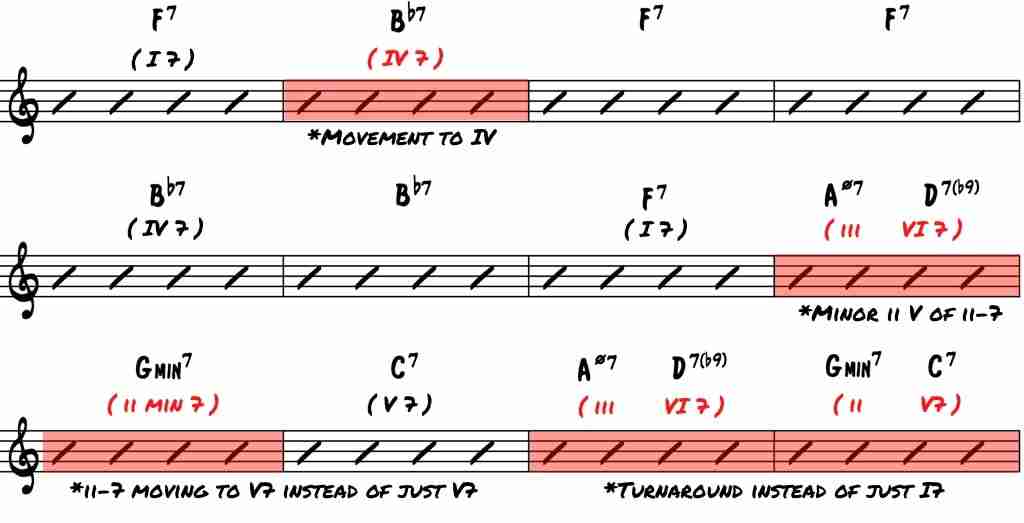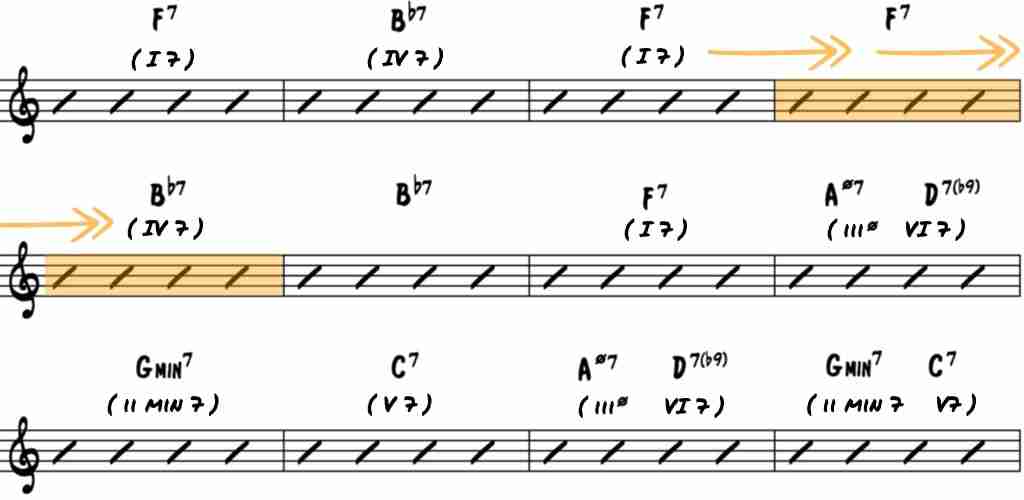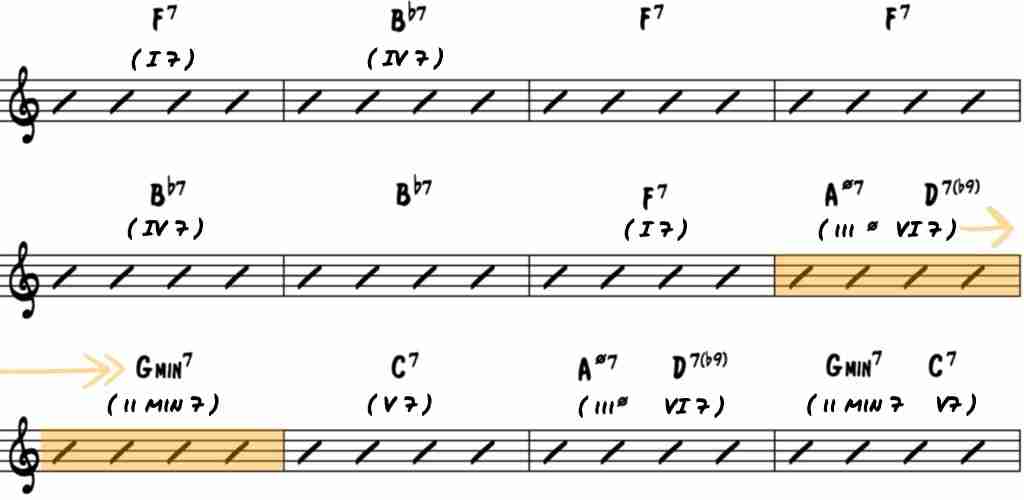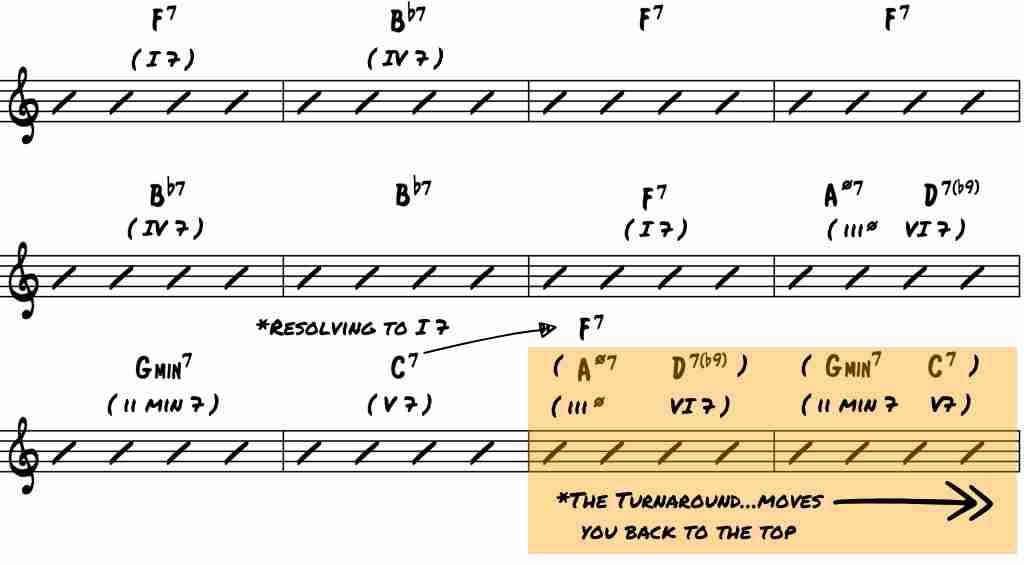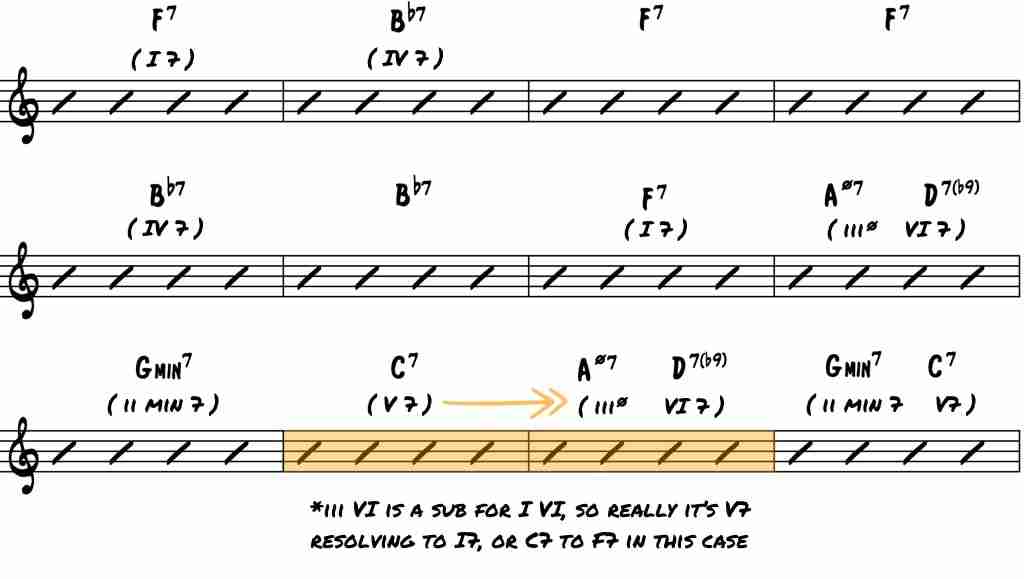Blues is the backbone of so much in jazz. The melancholic feeling. The soul. The call-and-response phrasing, walking groove, and clearly defined melodic statements…blues is ingrained in jazz at its very roots.
And every jazz musician at some point or another has to learn how to play the blues. There’s no way around it. If you want to play jazz, then you gotta play the blues…
But this doesn’t mean that you have to play in the blues style or run up and down a blues scale. You’re a jazz musician, and Jazz is different from blues.
And learning these specific differences, and how great jazz musicians approach the blues within the context of jazz, will help you grasp a jazz musician’s essential relationship to the blues.
First, let’s dive into what the term blues even means…
Blues 101
We refer to “blues” or “The blues” in jazz so much that you’ve probably never stopped to think what the term blues actually means…but here’s the thing…
When someone says “blues” it refers to two things:
- A style of music – a genre different from jazz with a specific feeling, mood, and language
- A musical form – a typical 12 bar musical form
And it’s important to realize this because in jazz, we use and are influenced by both the blues style and the blues form…
Take for instance the classic blues singer Ma Rainey.
Born in 1882, the Mother of The Blues sings with so much feeling and emotion, her musical stories can’t help but jump out at you…
The groove, vibe, and feel present in classic blues music like this, all play a crucial role in jazz…you see, from the blues style, we jazz musicians take the overall feeling, soul, and attitude into our own music…
All of these blues elements contribute to the way we hear, phrase, and swing in jazz.
And depending on the tune, it’s more front-and-center than other times…
Mulgrew Miller used to tell us all the time that the blues tradition was a part of his playing at its very core, and you can hear this at all times in his solos through his clear call and response phrasing, swing feel, and even his jazz language.
Take a listen to Mulgrew soloing on All The Things You Are and specifically listen for the blues influence on his playing…
It’s especially obvious in his language during this section…
Hear how his blues language rises to the surface, along with his swing, phrasing, and feel?
Where does this blues phrasing come from??
The key aspect that drives blues phrasing is the call and response lyric structure, which often consists of three distinct lyric phrases.
Go ahead and listen to Ma Rainey again on Deep Moaning Blues and this time pay special attention to the lyrics and the way they’re structured…
The lyrics, more or less, go like this…
My door bell this morning, don’t know which way to go
My bell rang this morning, didn’t know which way to go
I had the blues so bad, I sit right down on my floor
The first and second phrases are nearly identical and can be heard as a call. And the third phrase is different than the first two and can be heard as a response.
Each phrase leads into the next with a couple of pickup notes and lasts 4 measures for a total of 12 bars, creating the overall form of the blues.
The 12 bar blues form is one of the most important musical forms today – it has made its way not only into jazz, but all sorts of music, including rock, pop, and more. It’s literally everywhere!!
The underlying harmonic structure and chord changes of the basic blues strengthens the call and response nature of the lyrical structure.
Each 4 measure phrase of the blues is harmonically different and defined by a specific chord, which is how most people conceptualize a blues…three distinct pieces lasting 4 measures each…
The three distinct phrases of 4 bars each have different chordal characteristics:
- Piece #1 – Emphasizes the I chord
- Piece #2 – Emphasizes the IV chord
- Piece #3 – Emphasizes the V chord
Obviously blues chord changes can be different than this very typical version, but these changes should give you an idea of what a very basic blues tends to look like within the blues genre…
This chord movement between the 3 pieces supports the lyrical structure of the blues and gives the form its cyclical, endlessly repeating nature.
But when it comes to jazz, these basic blues changes don’t stop here because jazz musicians adapt everything to their style.
Jazz musicians tend to do a few things harmonically different when it comes to the blues form and these harmonic differences affect the melodic nature of jazz phrasing in the blues…
Blues Chord Changes VS. Jazz Blues Chord Changes
When you first approach a blues, you might think that it’s exactly the same as a blues in blues music, but in actuality, they can be quite different. Remember, jazz and blues are different.
You see, a “jazz blues” is a development upon the basic blues, adding extra layers of interesting harmony – the basic 12 bar blues form is obviously still there, but with a couple added twists and turns on top of it.
Here are just a few of the essential jazz chord changes typically added to a classic blues…
- The 2nd bar usually goes to the IV chord
- The 8th bar often uses a iii-7b5 VI7alt or just a VI7 for the whole bar to travel to the ii chord. This is a minor ii V of the ii chord. Also, as you’ll see in Parker’s playing later, iii minor is often used, along with countless other variations.
- Bars 9 and 10 commonly form a ii V7 progression rather than just using V7 for two measures
- Bars 11 and 12 will usually use some sort of Turnaround. It could be the classic I VI7 ii V7 or iii VI7 ii V7, or any other variation that moves you back to the beginning of the blues form.
These are just a few of the basic additions that jazz brings to the blues form.
Now, all of these chordal additions focus on one central theme: the emphasis on movement FROM one chord to ANOTHER.
And the reason behind adding these chords is simple…
In jazz, it’s not just what you play over a single chord that matters…it’s what you play FROM one chord to the NEXT.
The addition of these chords helps propel the music forward and emphasize a key element in jazz phrasing: the transitions.
Jazz Phrasing in The Blues: Playing the transitions
When a jazz musician plays over a blues, they tend to phrase differently than a blues musician, which completely changes the sound of their melodic lines.
In general, blues musicians tend to phrase with the natural divisions of the blues structure – the call and response structure of the blues lyrics .
When you phrase this way, your phrases are defined by the three different pieces of blues changes…
But jazz musicians like to highlight the movement from one piece of the blues to the next.
While jazz musicians do sometimes phrase like a blues musician, more often than not, they tend to emphasize the movement from one pivotal chord to another, the transitions.
This concept of focusing on the transitions, playing through them, and phrasing in a way that emphasizes the movement from one place to another, is a major difference between a jazz approach to the blues and a bluesy approach to the blues.
This is a HUGE part of jazz! We don’t just play on top of a chord, we play from one to the next, creating a seamless melodic line that flows BETWEEN chords.
In today’s lesson, we’re going to explore 3 of the most important transitions in the blues that every great jazz musician nails.
Nail the transition to the IV7 chord in a Blues
One of the most important transitions, if not the MOST important, in the blues takes place from measure 4 to measure 5…the I7 chord moving to the IV7 chord.
This important chordal relationship between I and IV defines the blues form.
And it’s a transition that every great player nails without question.
I can remember a time though when I had no idea about this transition. I would play an idea over the I chord for the first 4 bars…then pause right before the changes moved to the IV chord, and then play a new idea on the IV chord…
There’s nothing wrong with this way of thinking, but if it’s all you know, then you’re severely limiting yourself because most of the time, jazz musicians are focusing on the transitions and only a small part of the time will they relax and play more like a blues musicians, playing blues statements defined by the the three pieces of a blues.
So keep in mind that you want to have the ability to phrase in both ways, but most of the time, you want to lean toward nailing the transitions.
Rather than pausing before the IV chord, you want to play the transition from I to IV. You want to emphasize it and make your line effortlessly and clearly flow from one place to another.
Charlie Parker is a guy who does just that…every line effortlessly moves from one place to another, so natural and easy…
To hear this in action, have a listen to Charlie Parker take a few choruses on the blues Si Si.
Can you hear how he nails every single transition in the blues?
Well, if you can’t, not to worry because now we’re going to zero in on Parker’s perfect transitions that he nails every single time around.
Listen to this first line and how it pushes through the I7 chord to resolve on the IV chord…
That’s what we call nailing a transition.
No hesitation. No pause before the IV chord. He plays one continuous beautiful line that moves through the I chord into the IV chord.
Learning to play the I to IV transition is one of the biggest keys to the blues.
Now later in his solo, Bird plays his own substitute chord changes called Bird Blues chord changes.
These substitute chord changes help push his line forward, but it’s still the I7 to IV7 transition that makes the line work – by pushing through to the IV chord, the line has direction, meaning, and a clear resolution.
Again, his whole concept is to move one continuous melodic line through the first 4 measures and nail the transition from I to IV.
Just like Bird, as a jazz musician playing the blues, you need to focus on making this transition from I to IV as clear as possible…
Remember, we jazz musicians not only play over chords, we play through chords – in other words, we play the transitions from one chord to another.
The first transition and arguably the most important one in the blues is the I to IV transition, so spend plenty of time practicing this area and learning to use your jazz language here as effectively as possible.
Nail the transition to the ii chord in a Blues
The next transition that plays a key role in the blues for jazz musicians takes place between the second set of 4 bars and the third set – the transition from iii VI7 to the ii chord…
Now, the iii chord, just to clarify, can be a half diminished chord, a minor chord, or left out all together. Chord changes are very fluid in jazz, especially on the blues, so you’ll see and hear all sorts of variations. In this lesson, I’ve written the iii chord mostly as half diminished, however, Bird plays iii minor 7 as you’ll see in a moment.
This transition, besides the I to IV transition, is the next most important transition in the blues because it’s another transition between the three sets of 4 bars.
And you can tell in all the great players solos that they know the importance of this transition as well because they always nail it, using the sound of the VI7 chord or the iii VI7 chord to push their melodic line into the ii chord. (Of course there are a million variations of the iii VI chords, so beware)
Listen to how Bird uses his knowledge of the transition here to resolve and phrase his line in a way that sounds natural and melodically headed forward…
Again, emphasizing the transition makes his line feel and sound natural.
This is the big thing to remember about playing and understanding the transitions we’re talking about – they influence how you PHRASE your lines and where you RESOLVE them
And don’t think that any of this is a mistake…it’s ALL by design. Want proof?? Just look and listen to a few choruses ahead and you’ll hear Bird do nearly the same thing to nail the transition from VI to ii…
None of this is by accident. Charlie Parker is very very aware of these transition points in the blues and purposely phrases his lines in a way that focuses on them.
Once you have the I to IV transition under your belt, go ahead and start to practice the iii VI to ii transition, making sure to practice plenty of language in this area and integrate new material you’re working on here.
The two transitions we’ve talked about so far will improve your ability to solo on the blues by 10X, but just for good measure, here’s one more to think about…
Nail the transition right before the Turnaround in a Blues
The Turnaround in a tune is an interesting place of a tune because in a sense, the tune is actually over at the beginning of this point, yet the Turnaround is the thing that propels us back to the beginning of the form.
A little confusing?
Think about it like this…the point right before the Turnaround is the final cadence of the tune, and the Turnaround itself, usually the last two bars of a tune, helps move the harmony back to the beginning of the tune.
So, the start of a Turnaround can actually be treated as a resolution point.
With that in mind, it makes sense that the transition to the start of the Turnaround would be another transition to nail in the blues…
When you look at Bird’s playing in this area, it’s super clear that he made it a point to nail this transition into the Turnaround, and often treated it as a resolution to the Tonic.
And later in his solo, he again resolves his line at this point, but then continues his phrase through the Turnaround…
While this transition is not as paramount as the other two we talked about, it will make a difference in your playing if you learn to pay attention to it.
Like the other two, make sure to practice all your language and melodic techniques in this specific area of the blues.
Nailing the Transitions in the Blues
Today we hopefully changed how you conceptualize the blues…
I know that for my own playing, understanding these 3 key transitions in the blues made all the difference. Instead of flailing over a single chord, I suddenly had a direction for my melodic lines to go and resolution points to aim for.
When you shift your perspective and focus on the transitions from one place to the next, you’ll see what I mean…
Now, from today’s lesson, you should be able to easily tell me the answers to these questions:
- What does the term “blues” mean?
- What do jazz musicians take from blues?
- What importance do blues lyrics have when it comes to the form and phrasing of the blues?
- What’s the difference harmonically between a jazz blues and a bluesy blues?
- What key concept do jazz musicians tend to focus on that blues musicians don’t emphasize as much when playing the blues?
- What does it mean to “nail” a transition?
- What are three of the most important transitions in the blues?
If you payed attention, then I bet that was pretty easy for you…
Take your new understanding of these transitions and integrate them into your daily practice routine. Soon, the way you approach the blues will completely transform!!




